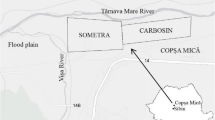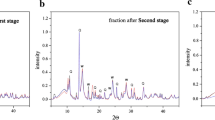Abstract
The sequential extraction procedure proposed by the European Commission Measurement and Testing Programme, combined with Scanning Electron Microscopy and Energy Dispersive X-ray Analysis(SEM/EDS), was applied to identify and quantify the chemical andmineralogical forms of Cu, Ni, Fe, Mn, Zn, Pb, Cr and Cd presentin the topsoil from a mining and smelting area near Sudbury (Ontario, Canada). The possible mobility of the chemical forms was also assessed. The metal fractions: (1) soluble and exchangeable, (2) occluded in manganese oxides and in easily reducible iron oxides, (3) organically bound and in form of sulphides, (4) residual mainly present in the mineral lattice structures were separated. Cu and Ni were the major metallic contaminants, occurring in soils in broad ranges of concentrations: Cu 11–1890 and Ni 23–2150 mg kg-1. Cu was uniformly distributed among allthe extracted fractions. Ni was found associated mainly withthe residual forms, accounting for 17–92%, with an averageof 64%, of the total Ni present in the soils. Fe, Mn, Zn,Pb, Cr and Cd, while occurring in most analysed samples innormal soil concentrations, were primarily held in theresidual mineral fraction (on average >50%). The solubleand exchangeable forms made a small contribution (≤8.1%)to the total content of metals extracted. At least 14% ofthe total Cd, Mn and Pb was mobilised from the reducibleforms. The oxidizable fraction assumed mean values higher than10% only for Pb and Zn. Statistical treatment of the experimental data showed significant correlations between totalmetal content of the soils, some soil properties such as pH value, clay and organic matter content, and metal concentrationsin the various fractions. SEM/EDS analysis showed Fe in form ofoxides and sulphides in soils and Cu, Ni, Mn, Zn and Cr in association with iron oxides. Numerous black carbonaceous particles and precipitates of aluminium fluoride salts, observedin the solid residue left after `total’ digestion, were found tocontain Fe, Ni and Cr.
Similar content being viewed by others
References
Abd-Elfattah, A. and Wada, K.: 1981, ‘Adsorption of lead, copper, zinc, cobalt and cadmium by soils that differ in cation-exchange materials’, J. Soil Sci. 32, 271–276.
Adamo, P., Dudka, S., Wilson, M. J. and McHardy, W. J.: 1996, ‘Chemical and mineralogical forms of Cu and Ni in contaminated soils from the Sudbury mining and smelting region, Canada’, Environ. Pollut. 91(1), 11–19.
Allen, H. E.: 1997, ‘Importance of speciation of metals in natural waters and soils to risk assessment’, Report of International Workshop on Risk Assessment of Metals and their Inorganic Compounds, International Council on Metals and the Environment, Ottawa, pp. 141–157.
Alloway, W. J.: 1995, ‘Soil Processes and the Behaviour of Heavy Metals’, in B. J. Alloway (ed.), Heavy Metals in Soils, Blackie Academic and Professional, London, pp. 11–35.
Berrow, M. L. and Reaves, G. A.: 1984, ‘Background Levels of Trace Elements in Soils’, International Conference on Environmental Contamination, CEP Consultants Ltd., England Edinburgh, London, U.K., pp. 333–340.
Bloomfield, C. and Pruden, G.: 1980, ‘The behaviour of Cr (VI) in soil under aerobic and anaerobic conditions’, Environ. Pollut. 23, 103.
Chao, T. T.: 1972, ‘Selective dissolution of manganese oxides from soils and sediments with acidified hydroxylamine hydrochloride’, Soil Sci. Soc. Amer. Proc. 36, 764–768.
Chao, T. T.: 1984, ‘Use of partial dissolution techniques on geochemical exploration’, J. Geochem. Explor. 20, 101–35.
Chao, T. T. and Zhou L.: 1983, ‘Extraction techniques for selective dissolution of amorphous iron oxides from soils and sediments’, Soil Sci. Soc. Amer. J. 47, 225–232.
Chuan, M. C., Shu, G. Y. and Liu, J. C.: 1996, ‘Solubility of heavy metals in a contaminated soil: effects of redact potential and pH’, Water, Air, and Soil Pollut. 90, 543–556.
Dudka, S. and Adriano, D. C.: 1997, ‘Environmental impacts of metal ore mining and processing: a review’, J. Environ. Qual. 26, 590–602.
Dudka, S. and Chlopecka, A.: 1990, ‘Effect of solid-phase speciation on metal mobility and phytoavailability in sludge-amended soil’, Water, Air, and Soil Pollut. 51, 153–161.
Dudka, S., Ponce-Hernandez, R. and Hutchinson, T. C.: 1995, ‘Current level of total element concentrations in the surface layer of Sudbury’s soils’, Sci. Total Environ. 162, 161–171.
Freedman, B. and Hutchinson, T. C.: 1980, ‘Pollutant inputs from the atmosphere and accumulation in soils and vegetation near a nickel-copper smelter at Sudbury, Ontario, Canada’, Can. J. Bot. 58, 108–132.
Hawley, J. E.: 1962, ‘The Sudbury ores: Their mineralogy and origin’, Can. Mineralogist 7, 1–208.
Hazlett, P. W., Rutherford, G. K. and van Loon, G. W.: 1983, ‘Metal contaminants in surface soils and vegetation as a result of nickel/copper smelting at Coniston, Ontario, Canada’, Reclamation and Revegetation Research 2, 123–137.
Hossner, L. R.: 1996, ‘Dissolution for Total Elemental Analysis’, in D. L. Sparks (ed.), Methods of Soil Analysis, Part 3 - Chemical Methods, SSSA Book Series: 5, SSSA/ASA, Inc. Madison, Wisconsin, U.S.A., pp. 49–64.
Hutchinson, T. C. and Whitby, L. M.: 1974, ‘Heavy-metal pollution in the Sudbury mining and smelting region of Canada, I. Soil and vegetation contamination by nickel, copper, and other metals’, Environ. Conservation 1(2), 123–132.
Hutchinson, T. C. and Whitby, L. M.: 1977, ‘The effects of acid rainfall and heavy metal particulate on a boreal forest ecosystem near the Sudbury smelting region of Canada’, Water, Air, and Soil Pollut. 7, 421–438.
Jahiruddin, M., Chambers, B. J., Cresser, M. S. and Livesey, N. Y.: 1992, ‘Effects of soil properties on the extraction of zinc’, Geoderma 52, 99–208.
Kabata-Pendias, A. and Pendias, H.: 1992, Trace Elements in Soils and Plants, CRC Press, Boca Raton, Florida, 365 pp.
Kersten, M. and Förstner, U.: 1995, ‘Speciation of Trace Metals in Sediments and Combustion Waste’, in A. M. Ure and C. M. Davidson (eds), Chemical Speciation in the Environment, Blackie Academic and Professional, London, pp. 234–275.
Lena, Q. M. and Gade, N. R.: 1997, ‘Chemical fractionation of Cadmium, Copper, Nickel and Zinc in contaminated soils’, J. Environ. Qual. 26, 259–264.
Levy, D. B., Barbarick, K. A., Siemer, E. G. and Sommers, L. E.: 1992, ‘Distribution and partitioning of trace metals in contaminated soils near Leadville, Colorado’, J. Environ. Qual. 21, 185–195.
Lindsay, W. L.,: 1979, Chemical Equilibria in Soils, John Wiley & Sons, New York.
McGrath, S. P.: 1995, ‘Chromium and Nickel’, in B. J. Alloway (ed.), Heavy Metals in Soil, Blackie Academic and Professional, London, pp. 152–178.
McKenzie, R. M.: 1980, ‘The adsorption of lead and other heavy metals on oxides of manganese and iron’, Aust. J. Soil Res. 18, 61–73.
Ministry of Environment: 1990, Studies of the Terrestrial Environment in the Sudbury Area 1978 to 1987, prepared by J. J. Negustanti and W. D. McIlveen, Ministry of the Environment, Northeastern Region, Ontario, 70 pp.
Ministry of Environment: 1992, Air Quality Monitoring Studies in the Sudbury Area 1978 to 1988, prepared by D. J. Dobrin and R. Potvin, Ministry of the Environment, Technical Assessment Section, Northeastern Region, Ontario, 128 pp.
Narwal, R. P. and Singh, B. R.: 1998, ‘Effect of organic materials on partitioning, extractability and plant uptake of metals in an alum shale soil’, Water, Air, and Soil Pollut. 103, 405–421.
Pickering, W. F.: 1998, ‘Metal ion speciation-soils and sediments’, Ore Geol. Rev. 1, 83–146.
Rapin, F. and Förstner, U.: 1983, ‘Sequential Leaching Techniques for Particulate Metal Speciation: The Selectivity of Various Extractants’, in G. Müller (ed.), Heavy metals in the Environment, Int. Conf. Heidelberg, Vol. 2, Edinburg CEP, pp. 1074–1077.
Richter, R. O.: 1978, ‘Chemical Speciation of Fly Ash Leachate in the Underlying Soil/Water System with Emphasis on the Adsorption of Nickel by Oxides’, Ph.D. Dissertation, University of Notre Dame.
Rutherford, G. K. and Bray, C. R.: 1979, ‘Extent and distribution of soil heavy metal contamination near a nickel smelter at Coniston, Ontario’, J. Environ. Qual. 8, 219–222.
Singh, S. P., Tack, F. M. and Verloo, M. G.: 1998, ‘Heavy metal fractionation and extractability in dredged sediment derived surface soils’, Water, Air, and Soil Pollut. 102, 313–328.
Stahl, R. S. and James, B. R.: 1991, ‘Zinc sorption by B horizon soils as a function of pH’, Soil Sci. Soc. Am. J. 55, 1592–1597.
Taylor, J. G. and Crowder, A. A.: 1983, ‘Accumulation of atmospherically deposited metals in Wetland soils of Sudbury, Ontario’, Water, Air, and Soil Pollut. 19, 29–42.
Tessier, A., Campbell, P. G. C. and Bisson, M.: 1979, ‘Sequential extraction procedure for the speciation of particular trace metals’, Analyt. Chem. 51, 844–850.
Theis, T. L. and Richter, R. O.: 1979, ‘Chemical speciation of heavy metals in power plant ash pond leachate’, Environ. Sci. Technol. 13, 219–224.
Ure, A., Quavaullier, Ph., Muntau, H. and Griepink, B.: 1993, ‘Speciation of heavy metals in soils and sediments. An account of the improvement and harmonisation of extraction techniques undertaken under the auspices of the BCR of the CEC’, Int. J. Environ. Analyt. Chem. 51, 135–151.
Whitby, L. M., Stokes, P. M., Hutchinson, T. C. and Myslik, G.: 1979, ‘Ecological consequences of acidic and heavy-metal discharged from the Sudbury smelters’, Can. Mineral. 14, 47–57.
Author information
Authors and Affiliations
Corresponding author
Rights and permissions
About this article
Cite this article
Adamo, P., Dudka, S., Wilson, M.J. et al. Distribution of Trace Elements in Soils from the Sudbury Smelting Area (Ontario, Canada). Water, Air, & Soil Pollution 137, 95–116 (2002). https://doi.org/10.1023/A:1015587030426
Issue Date:
DOI: https://doi.org/10.1023/A:1015587030426




